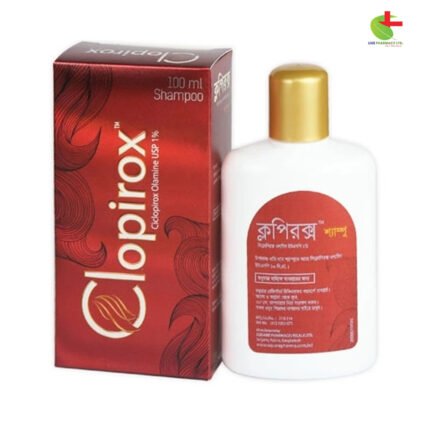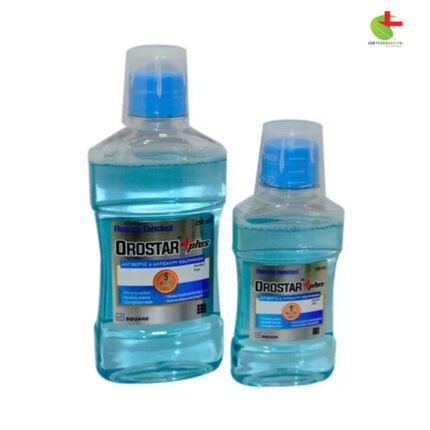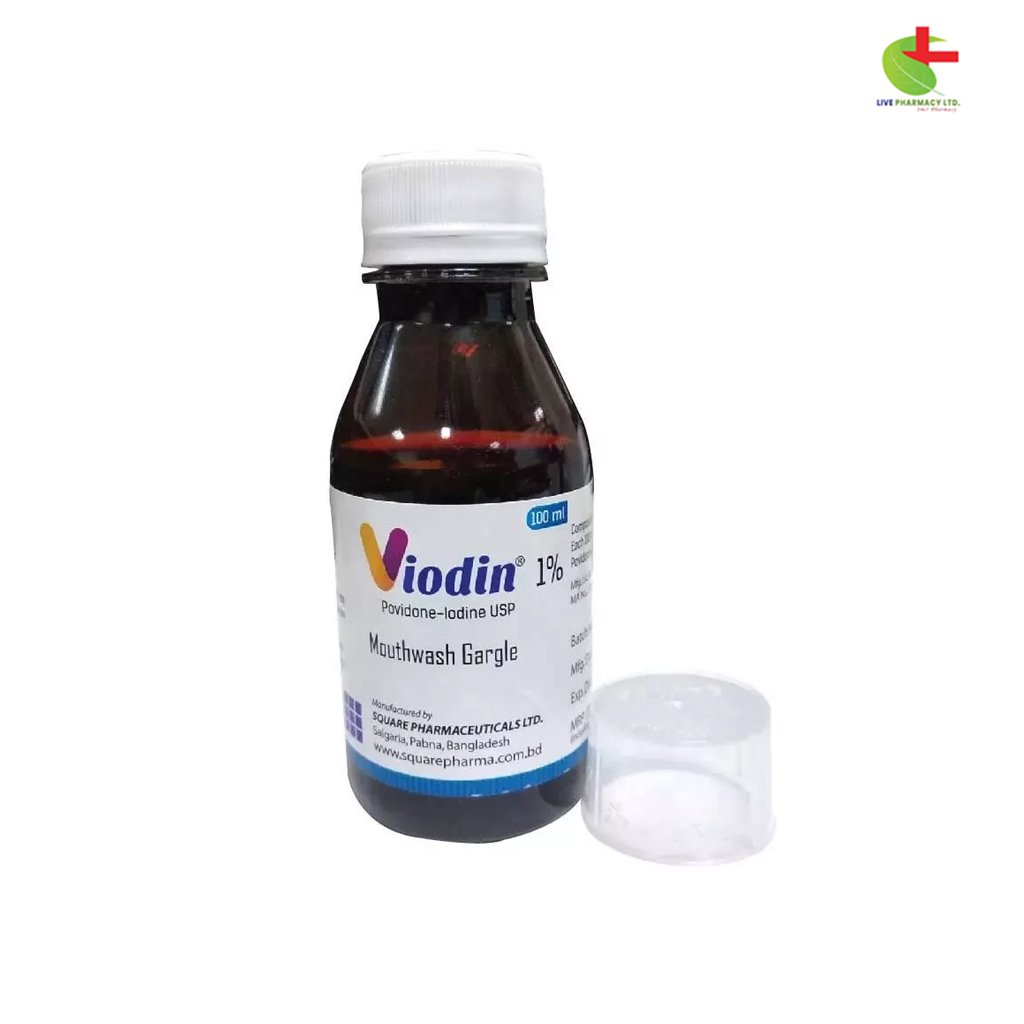

Viodin 1% Mouthwash
50.00৳ Bottle (100 ml)
- Viodin, distributed by Live Pharmacy under the brand Square Pharmaceuticals PLC, offers a comprehensive line of antiseptic solutions.
- Formulations include creams, ointments, solutions, and powders tailored for treating and preventing various infections.
- Povidone Iodine, the active ingredient, provides broad-spectrum antimicrobial action against bacteria, fungi, viruses, and protozoa.
- Used in surgical settings for preoperative scrubbing, wound disinfection, and postoperative care.
- Also available in formulations suitable for oral hygiene and ophthalmic applications, ensuring versatile and effective infection control measures.
 Brand
Brand
|
Square Pharmaceuticals PLC |
|---|---|
 Generics
Generics
|
Povidone Iodine |
Indications:
Cream or ointment: Therapeutically, it serves as an adjunct to systemic therapy for primary or secondary topical infections, infected surgical incisions, decubitus or stasis ulcers, pyodermas, secondarily infected dermatoses, and traumatic lesions. Prophylactically, it prevents microbial contaminations in burns, incisions, and other topical lesions, and aids in degerming skin during hyperalimentation procedures, umbilical care, or circumcision, facilitating wound healing for minor cuts, abrasions, and wounds.
Solution: Used for the prevention and treatment of surface infections, degerming of skin, mucous membranes, and hyperalimentation procedures, as well as for seborrhea. It’s also employed for preoperative and postoperative scrubbing in hospital operating rooms and equipment, and for preoperative preparation of operative sites including the vagina. Additionally, it disinfects wounds, burns, lacerations, and abrasions, acting as a prophylactic anti-infective agent in various healthcare settings.
Gargle & Mouthwash: This pleasantly flavored solution is utilized for treating acute mucosal infections of the mouth and pharynx, and for maintaining oral hygiene before, during, and after dental and oral surgery procedures.
Surgical Scrub: As a golden surfactant solution, it forms a rich lather used as an antiseptic skin cleanser for preoperative and postoperative scrubbing by surgeons and operating theatre staff, and for preoperative patient skin preparation.
Powder: Applied topically, it serves to treat superficial wounds, minor cuts, burns, abrasions, lacerations, and aids in the prevention of infections.
Ophthalmic Solution (Viodin): Primarily indicated for the symptomatic treatment of dry eye conditions including keratoconjunctivitis sicca, and serves as a substitute for tear fluid in cases of unstable tear film or insufficient moistening of the eye surface.
Pharmacology:
Povidone Iodine is a complex of iodine and povidone, exhibiting superior germicidal activity compared to elemental iodine. It acts rapidly against a broad spectrum of microorganisms including Gram-positive and Gram-negative bacteria, protozoa, viruses, fungi, and yeasts. Povidone Iodine is also sporicidal, maintains efficacy in the presence of various substances like soap, blood, serum, pus, and mucosal secretions, and exerts a prolonged germicidal action.
Dosage & Administration:
Cream or ointment: Apply once or twice daily for up to 14 days for treatment of infections, or once or twice weekly for prevention. Ensure the affected area is clean and dry, and may be covered with a dressing or bandage.
Solution: Apply full strength as needed, using paint, spray, or wet soak methods, and may be bandaged if necessary.
Gargle & Mouthwash: For adults and children over 6 years, use undiluted or diluted with an equal volume of warm water. Gargle or rinse with up to 10 mL for up to 30 seconds without swallowing. Repeat up to four times daily for up to 14 consecutive days, or as directed by a dental or medical professional.
Surgical Scrub: For surgical personnel, wet hands and forearms, apply approximately 5 mL of Povidone Iodine Surgical Scrub, rub thoroughly for five minutes without adding water, and rinse under running water. For preoperative use on patients, apply a sufficient amount to cover the area, develop lather, and scrub for about five minutes. Rinse thoroughly with sterile gauze saturated with water.
Powder: Apply a light dusting to the affected area as needed. No special dosage adjustments are typically necessary for children or elderly patients.
Ophthalmic Solution: Instill one drop into the conjunctival sac four times daily, or as needed based on the severity of the condition.
Interaction:
Povidone Iodine exhibits interactions with strong alkali, sodium thiosulfate, sodium metabisulfite, and thiomersal. Concurrent use with lithium therapy may result in hypothyroidic effects.
Contraindications:
Avoid use in individuals with hypersensitivity reactions to any components of the product. It is also contraindicated in patients with thyroid disorders, particularly nodular colloid goiter, endemic goiter, and Hashimoto’s thyroiditis, as well as in patients receiving lithium therapy. Evaluate serum iodide levels in severely burnt patients before use.
Side Effects:
Potential side effects may include hypersensitivity reactions, skin and mucous membrane irritation, and systemic effects such as metabolic acidosis, hypernatremia, and renal function impairment.
Pregnancy & Lactation:
Povidone Iodine Cream, Solution, and Powder are not recommended during pregnancy due to potential fetal thyroid effects. Consult a healthcare provider regarding use during lactation. Use of Gargle & Mouthwash and Surgical Scrub should also be avoided in pregnant and lactating women unless necessary.
There is insufficient data on the safety of Povidone Iodine Ophthalmic Solution during pregnancy or lactation. Use during these periods should be avoided except for compelling reasons.
Precautions & Warnings:
Exercise caution in case of deep or puncture wounds, serious burns, or if redness, irritation, swelling, or pain persists or increases, discontinue use and consult a healthcare provider. Avoid prolonged use, especially in children, patients with thyroid disorders, or those on lithium therapy.
Therapeutic Class:
Iodine compounds (Antiseptic Preparations).
Storage Conditions:
Store below 25°C, avoid freezing, and keep in a cool, dry place protected from light. Keep out of reach of children. Do not touch the ophthalmic solution dropper tip to any surface to prevent contamination. Discard the ophthalmic solution one month after opening.











Reviews
There are no reviews yet.